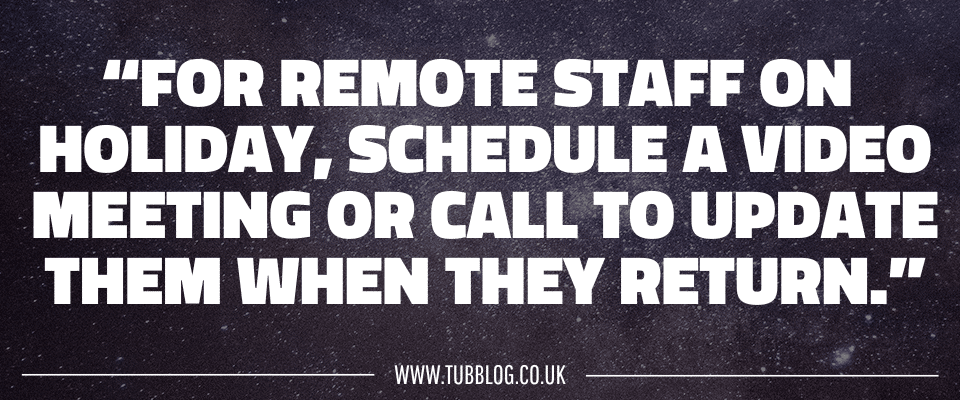So you’ve authorised the annual leave requests, agreed that your staff will leave work equipment at home and now they’re on the hunt for a new bucket and spade. But before you wave them off at the airport, here are seven things to think about as they take time off.
Out of Office Policy
An out-of-office email auto-response is standard these days – you can even set them on Google Mail. But it’s still a good idea to have a policy or a template so that the whole team uses the same message.
This might include information on when they’re absent and when they’re back in the office, as well as who to contact if the other person needs something sooner rather than later.
This is also a good opportunity to point people towards useful blogs or other content that could answer questions in the employee’s absence – it shows that you’ve anticipated their needs.
As well as demonstrating professionalism and transparency, your out of office email might also be a compliance requirement. Make sure you explain your reasons to all employees before they take time off.
However, depending on your company and the type of work you do, it might not be a good idea to let people know that staff are absent. I’ve come across MSPs who don’t use out of office messages, and clearly explain why they don’t.
Call/Email Redirection
Ask your employee to set up call and/or mail forwarding and test it before they leave for their holiday. If it’s not something they do often, make sure they know where to go for help. You might even include it in your holiday policy.
Make sure your other staff know who to contact while their colleague is off. It quite likely isn’t the same person who’s named in the out-of-office message. Agree with that third party what their availability and responsibilities are to the team members.
Handover Process – Before They Take Time off
Whether a team member or an external supplier is covering a holiday absence, a handover process is important. This might need to be done prior to the vacation. Or it could be a list of instructions with key contacts left for the next person.
Make it clear where and how the handover document is saved and shared. There could be a video walkthrough if that makes it easier to do a handover. Recruitment specialists Reed recommend including things like regular tasks, guidance on using software and a summary of key processes and systems.
If the employee taking time off is involved in an ongoing project, it will be necessary to include the project brief, goals and desired outcomes. A Gantt Chart or other milestone tracker should be shared, along with key contacts and the name of the project lead.
It’s good practice to share the handover document well in advance of the employee’s holiday, to allow anyone covering time to ask questions and get clarification on things. If this is a key business role, schedule time to review it at regular intervals to ensure it’s up to date and any contacts mentioned are still in their roles.
Cover for Time off
The amount of cover required will vary from role to role, and it will also depend on the need of the organisation during the employee’s absence. If it’s a manager, it’s reasonable to assume that someone else at the same grade will take over.
If they’re having an extended vacation, you may decide to ask someone to step up in the interim. Or if you have a large company, this could be a secondment opportunity or even require a temp from outside the organisation.
Ensure that the team knows who they’ll be reporting to and what support they can expect. Any important information the temporary manager needs to have should be included in the handover document.
If it’s an engineer taking time off, find a colleague to take over their work, or adjust their workload so they can pick tasks up on their return. Cover isn’t always necessary, and there can be costs involved, so make this role-dependent.
In Case of Emergency
If you’ve got a strong handover process in place and there’s cover for the role, there really shouldn’t be an emergency situation. But if something does crop up, make sure you’ve clarified the steps with the absent staff member first.
Agree what constitutes an emergency for their role. Ask junior team members to speak to another manager or HR colleague before contacting the person on holiday. It might be a good idea for you or the manager to get in touch, rather than the team member.
And make sure that the employee’s emergency contact information isn’t shared in either their out-of-office message or with the wider team! They’ve earned their time off and don’t need to be bothered with minor inconveniences.
Who Else Can Help During Their Time off?
There should never be a situation where the employee who’s off is the only person who holds a key piece of information or knows how to do something. And if you’re running a successful MSP, you already know the risks of a single point of failure!
Again, it will depend on their role. But you need to ensure that at least one other employee knows how to do their work. Otherwise, this could constitute an emergency and you’ll need to contact the staff member on holiday!
If the information isn’t in the handover document, it might be their secretary who holds it. Or their counterpart in a different team should be able to help. Clarify this before they go on leave.
How to Update Them When They Get Back
To an extent, this will depend on the set-up of your business. If they work remotely, a video meeting or even a call might be sufficient. If they’re based in the office, do they need a catch-up meeting?
It might require a handover meeting from whoever was providing cover. Or perhaps there’s a briefing document that could be shared. However you decide to do it, make sure the staff member knows what to expect. And give them time to get caught up before you send them more work!
Have you got a holiday checklist that you use with your MSP employees? What else is important for you to tick off before people have time off? Let us know in the comments!



















Comments